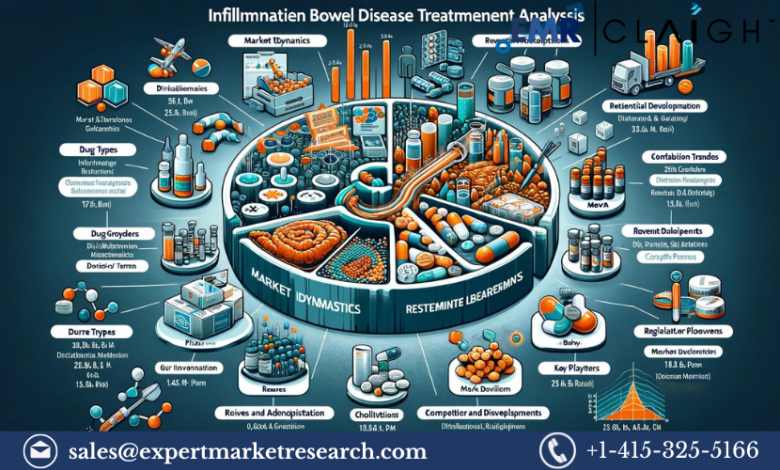Health
Exploring the Inflammatory Bowel Disease (IBD) Treatment Market 2032

What is Neovascular AMD?
- Detailed Overview: Neovascular AMD, also known as wet AMD, is a chronic eye disorder that causes blurred or distorted central vision due to abnormal blood vessels growing under the retina. This can lead to severe vision loss and is primarily seen in older adults.
- Pathophysiology: These abnormal vessels leak blood and fluid into the retina, leading to scarring and rapid vision loss. Explain the mechanism of neovascular AMD at a cellular level, detailing the role of vascular endothelial growth factor (VEGF) in promoting abnormal blood vessel growth.
2. Market Insights: Growth and Projections
- Market Size and Forecasts: Present the valuation of the neovascular AMD treatment market, which reached USD 11 billion in 2023 across major global markets, and discuss the CAGR of 7.5% projected to take the market to USD 21.1 billion by 2032.
- Key Growth Drivers:
- Aging Population: Detail the impact of the global aging population, which is increasing the prevalence of age-related diseases, including AMD.
- Technological Advancements: Discuss recent breakthroughs such as gene therapy, advanced anti-VEGF treatments, and new drug delivery systems that enhance treatment efficacy and patient compliance.
- Increased Awareness: More patients and healthcare providers are recognizing the importance of early diagnosis and treatment of AMD, improving patient outcomes.
- Trends to Watch:
- Gene Therapy: Companies are investing heavily in gene therapies to treat AMD, focusing on one-time treatments that address the underlying genetic causes rather than just symptoms. Provide examples of ongoing clinical trials or recent FDA-approved gene therapies.
- Advanced Drug Delivery Systems: Explain the development of sustained-release injections or implants that reduce the frequency of anti-VEGF injections, which currently require frequent administration and can be burdensome for patients.
- Teleophthalmology: Describe the trend of remote monitoring for AMD patients, which is especially useful for elderly individuals who may have mobility issues. Highlight how telemedicine can improve access to specialists and enable more frequent monitoring.
3. Opportunities and Challenges
- Opportunities:
- Expansion in Emerging Markets: With improvements in healthcare infrastructure, there’s a growing market for AMD treatments in emerging economies, where the aging population is increasing.
- Increased R&D Funding: Significant investment is being funneled into developing AMD treatments, with pharmaceutical companies focusing on more effective and longer-lasting solutions.
- Challenges:
- High Costs of Advanced Therapies: Many advanced treatments, especially biologics, are expensive. For example, anti-VEGF therapies can cost thousands of dollars per injection, limiting access for some patients.
- Regulatory Hurdles: Discuss the rigorous regulatory environment, particularly for gene therapies, which must meet strict safety and efficacy standards before approval.
- Patient Compliance: Frequent injections or office visits may affect treatment adherence, leading to suboptimal outcomes.
4. Future Outlook for Neovascular AMD Treatment
- Gene Editing and Regenerative Medicine: Research is increasingly focused on gene editing and stem cell therapies to repair or replace damaged retinal cells, potentially offering a cure rather than temporary relief.
- Combination Therapies: Explain the potential for combination therapies that target multiple pathways to inhibit abnormal blood vessel growth and reduce inflammation, promising better long-term outcomes.
Exploring the Inflammatory Bowel Disease (IBD) Treatment Market
1. What is Inflammatory Bowel Disease?
- Overview: Inflammatory Bowel Disease (IBD) is a broad term for chronic inflammation of the gastrointestinal (GI) tract, primarily Crohn’s disease and ulcerative colitis. Both conditions cause severe inflammation and a range of symptoms such as abdominal pain, diarrhea, and weight loss.
- Disease Mechanism: Discuss the role of immune system dysfunction in IBD, where the body’s immune cells attack healthy tissue in the digestive tract, leading to chronic inflammation.
- Current Treatments: Outline standard treatments, including anti-inflammatory drugs, immunosuppressants, biologics, and the recent use of JAK inhibitors, which reduce inflammation by targeting specific pathways.
2. Market Dynamics: Growth, Trends, and Projections
- Market Drivers:
- Rising Prevalence of IBD: With lifestyle changes and increased awareness, the prevalence of IBD is growing worldwide, driving demand for effective treatments.
- Advances in Biologics: The introduction of biologics, which target specific immune pathways, has significantly improved treatment outcomes for IBD patients.
- Improved Diagnostic Techniques: Advances in diagnostic technology allow for earlier and more accurate diagnosis of IBD, helping to initiate treatment sooner.
- Key Market Trends:
- Biologics and Biosimilars: The market is witnessing a strong shift towards biologic therapies, which have shown significant efficacy in managing IBD symptoms. Biosimilars, which are less expensive alternatives to biologics, are also gaining traction as they offer more affordable treatment options.
- Personalized Medicine: As understanding of the disease’s genetic and molecular underpinnings grows, treatment approaches are increasingly tailored to each patient’s unique profile, improving effectiveness and reducing side effects.
- Telemedicine for IBD: Patients with IBD often require frequent monitoring and medication adjustments, making telemedicine a convenient solution for managing symptoms and improving quality of care.
3. Leading Players in the IBD Treatment Market
- Pfizer Inc.: Known for its JAK inhibitor Xeljanz (tofacitinib) for ulcerative colitis, Pfizer is also exploring new biologics and partnerships to expand its IBD portfolio.
- GlaxoSmithKline plc (GSK): GSK’s biologics portfolio is continuously evolving, with a focus on therapies that modulate the immune system to reduce inflammation in IBD patients.
- Novartis AG: Novartis is expanding the indications for its existing treatments and investing in the development of novel therapies to improve long-term patient outcomes.
- Mylan N.V.: Mylan plays a significant role in making biosimilars available, especially in regions looking for cost-effective solutions to IBD treatment.
- Other Key Players: Companies like Teva Pharmaceutical Industries Ltd., Sanofi SA, and Janssen Pharmaceuticals Inc. are also significant players, each contributing to advancements in IBD treatment.
4. Competitive Landscape and Strategic Initiatives
- Patent and Grants Analysis: Pharmaceutical companies protect their innovations through patents, while grant funding supports ongoing research into IBD treatments.
- Clinical Trials and R&D: Highlight major clinical trials and research projects aiming to introduce new drugs and therapies. For example, newer JAK inhibitors and immune-modulating agents are showing promising results in clinical trials.
- Investment Trends: The influx of funding from both public and private sectors underscores the importance of advancing IBD treatment. Investments in biologics and biosimilars are particularly high.
5. Challenges in the IBD Treatment Market
- High Cost of Biologics and Other Advanced Treatments: Biologic drugs and targeted therapies are often expensive, posing accessibility issues, especially in regions with limited healthcare funding.
- Side Effects and Safety Concerns: Long-term use of biologics can have serious side effects, such as increased susceptibility to infections.
- Competition from Biosimilars: As patents for blockbuster biologics expire, biosimilar competition is increasing, pressuring original biologic manufacturers to lower prices or innovate further.
6. Future of IBD Treatment
- Microbiome-Targeted Therapies: The microbiome’s role in IBD is increasingly recognized, leading to treatments that focus on altering the gut microbiota to reduce inflammation.
- Stem Cell Research: Emerging treatments are exploring the use of stem cells to repair damaged tissue in the digestive tract, potentially offering a regenerative approach to IBD treatment.
- Regulatory Considerations: Regulatory bodies are increasingly focused on ensuring the safety of IBD therapies, especially as new types of treatments, like gene and cell-based therapies, enter the market.





